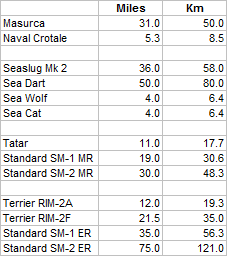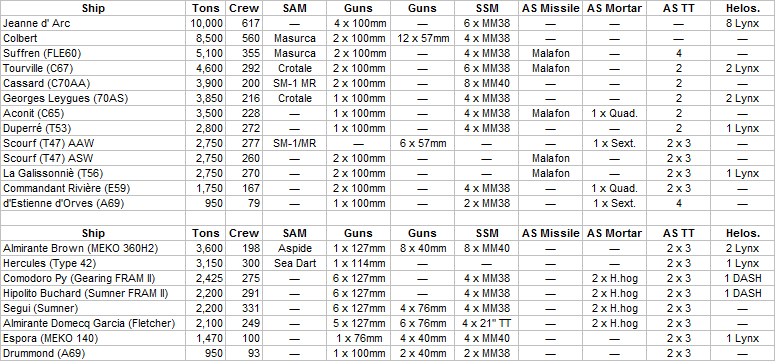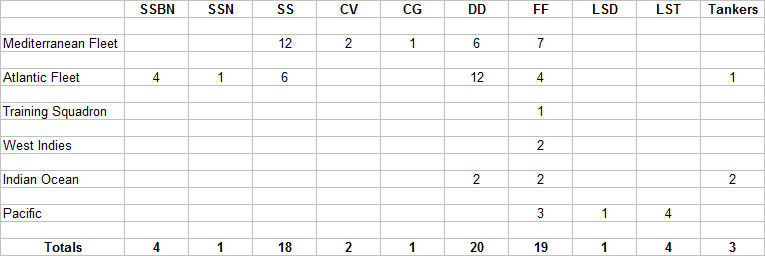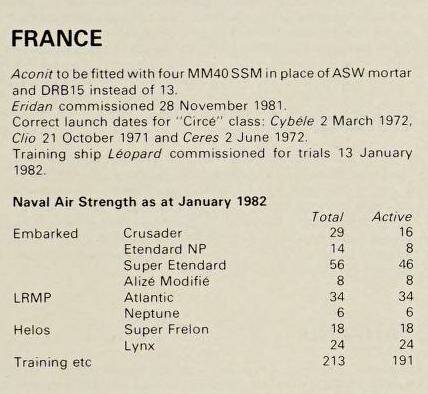alejandrogrossi
ACCESS: Secret
- Joined
- 20 September 2019
- Messages
- 266
- Reaction score
- 445
NOMISYRRUCArgentine Aircraft CarriersShould your second sentence be? Why can't Argentina buy the Type 42 for the Navy?NOMISRRUCI don't remember this being asked before and haven't checked the thread to see if it has.
Does swapping France with the UK mean that the latter doesn't sell 2 Type 42 destroyers to Argentina and in their place the former sells 2 Masurca armed destroyers to Argentina instead?
Does it also mean that France doesn't sell Super Etendards, 3 A69 corvettes and Exocet missiles to Argentina? What do the British sell in their place. I was going to say Buccaneers and Martels in place of the Super Etendards and AM39 Exocets but I doubt that the Argentine aircraft carrier could cope with the Buccaneer.
If the swap is UK with France
Why not the Our can not buy the Type 42 for the Navy.
Of course, we have not SUE or the A69, and Exocet.
See my post 41 / 64 and 71. There I do the changes in our aerial equipment, that demand this swap.
And the third sentence be? Of course we do not have SUE [Super Etendard] or the A69 and Exocet.
My thinking was that, as the thread is swap the UK with France as Argentina's opponent, should the British equipment that the Argentines had in the Falklands be substituted with French equipment as well? And vice versa, that is, should the French equipment that the Argentines used be substituted with British equipment?
That's:
I'm going to write separate posts about your Posts 41, 64 and 71.
- The pair of Type 42 destroyers ordered in 1970 plus the second-hand Canberras (that I didn't remember until writing this reply) from Britain.
- And the 3 A69 corvettes, 14 Super Etendards, Exocet missiles and the Mirage IIIs (you mentioned in Post 41 that I forgot about) from France.
The sale of Arromanches to Argentina to give them a second aircraft carrier has been suggested in this thread. Not by you or I. However, it's worth examining.
Arromanches was retired in 1974, which was 3 years after the Argentines scrapped Independencia, which (when it was HMS Warrior) was refitted to a similar standard to Arromanches. As far as I know they were in the same material condition in 1971 so the Argentines would have kept Independencia if they wanted a second carrier. The only way that I can see Argentina buying Arromanches is to provide a source of spare parts for Veinticinco de Mayo
Furthermore, if France was prepared to sell Arromanches to Argentina in this timeline other countries would have been prepared to sell their aircraft carriers to Argentina too.
The Canadians might have sold Bonaventure to Argentina instead of having it broken up in 1970. Unlike Arromanches and Independencia she had a steam catapult and had recently completed the 1960s version of a SLEP refit.
Though the best ships available (and by coincidence the ones that best fit the sprit of the timeline) are Centaur and Hermes.
Therefore, the best alternative for Argentina would be to buy Centaur and Hermes in 1968 instead of Karel Doorman and the proposed purchase of Arromanches.
- Centaur was paid off at the end of 1965 and used as an accommodation ship until 1970 but wasn't sold for scrap until 1972. It was newer, larger and faster than Karel Doorman. It also had 2 steam catapults to Karel Doorman's one. However, the Dutch ship's catapult had a longer shuttle run and may have been as powerful. Karel Doorman had a fully angled flight deck while Centaur only had a partially angled flight deck.
- Hermes was paid off in 1970 and converted to a commando carrier 1971-73 when it replaced Albion. It was a far superior ship to Arromanches on account of it being newer, larger and faster. Both ships had interim angled flight decks, but before her conversion to a commando carrier Hermes had 2 steam catapults that could launch Buccaneers instead of the single hydraulic catapult on Arromanches.
Jane's 1982-83 said Veinticinco de Mayo had an air group of 18 fixed wing aircraft (Skyhawks and Trackers) and 4 helicopters (Sea Kings). However, it's been pointed out on another thread that she couldn't have put to sea with a full-strength air group due to attrition.
- Centaur would probably need a refit before it could be delivered to the Argentines. It's possible that this might include upgrading the ship to operate Buccaneers.
- In common with our timeline, Hermes would remain in service with the Royal Navy until 1970, but it would then be transferred to Argentina. Her place in the Royal Navy after 1973 would be taken by Albion which would be run on until paid off in 1984 (instead of 1973) and possibly be sold to India afterwards.
I think Centaur and Hermes could have carried 50% more aircraft of equivalent size to those operated by Veinticinco de Mayo and the Argentines would have bought 3 times as many aircraft to operate from them. However, attrition would have meant that these ships wouldn't have been able to put to sea with full-strength air groups either.
- 11 Skyhawks were left out of the 16 purchased with 8 aboard the carrier and 3 ashore.
- Of 6 S-2E in service only 5 were operational with only 4 deploying on the carrier at any one time.
- Of 5 SH-3D in service in May 1982 only 3 were operational.
Except that another source I have says that the Argentines bought 6 S-2E Trackers in the 1960s and the 6 S-2E Trackers were delivered in 1978 and at least 3 of the S-2As were left in 1982 because they were deployed to BAN Río Grande in Tierra del Fuego when the S-2Es replaced them aboard the carrier.
- 33 Skyhawks would have been left out of the 48 purchased with 24 aboard the carriers and 9 ashore.
- Of 18 S-2E in service only 15 would be operational with only 12 deploying on the carriers at any one time.
- Of 15 SH-3D in service in May 1982, only 9 would be operational.
All other things being equal the Argentines would have acquired 18 S-2A Trackers in the 1960s and 18 S-2E Trackers in 1978. However, I think it would have been 12 S-2A Trackers & 6 E-1A Tracers in the 1960s and 12 S-2E Tracers & 6 E-1B Tracers in 1978. Therefore, the two Argentine carriers would have had an AEW capability that the real carrier lacked.
Except I think the Argentines would have bought new Buccaneers, second-hand Sea Vixens and second-hand AEW Gannets to operate from the ships instead of Skyhawks, Trackers and Tracers.
According to Marriott in RN Aircraft Carriers 1945-1990 Centaur's final air group in RN service was 24 aircraft (12 Sea Vixens, 8 ASW helicopters and 4 AEW Gannets). However, the refit that she would have had before delivery to Argentina might have included increasing her carrying capacity to that of Hermes as well as upgrading the ship to operate Buccaneers.
According to seaforces.org it Hermes had an air group of 30 aircraft 1966-70 made up of 7 Buccaneers, 12 Sea Vixens, 5 Gannets (4 AEW and one COD) and 6 helicopters. However, Ballance, Howard & Sturtivant say that her Buccaneer squadron had 8 aircraft from 1966 to 1970 except for August 1968 to April 1969 when it was increased to 12 and none of the other squadrons were reduced.
Therefore, I think the two ships in Argentine service would have air groups of 36 aircraft made up of 12 Sea Vixens, 12 Buccaneers, 6 Gannets (4-5 AEW and 1-2 COD) and 6 helicopters. Except that by 1982 attrition probably meant that there weren't enough aircraft for 2 full-strength air groups.
This is a long way from what the thread's Opening Post asked and is more like a Contrive the best possible Argentine Navy in 1982 thread.
I read all you posts. I´m speechless
Great work.
Some thoughts:
You choose the Lightnings (for MIII and Dagger) I choose the Sea Vixen (to replace the M-III), because I think (my opinion) it had more range, so you can reach and operate more time over the islands
Daggers: I choose the Bucc (one of my favorite britihs aircraft) becase the Dagger (in the war) do strike mission over the islands, more that fighter. My selection was base in the actual knowledge the the Dagger arrive to the islans with few fuel; and for that, they use the same route for in and out.
For your idea, about 2 carrier for our Navy.
By short time, we operated 2, (at the time of the withdraw of Independencia and the enter of service of the Veinticinco de Mayo) I don remeber how many time was that (2 carriers), but from of our historical budget , it´s not possible.
One of your choises (Centaur o Hermes ) i like it.
One question
Why not the Victorious ( I know about the fire), but we buy it and do the repairs in UK
here a Victorius with Ducht island, and SUE and A-4Q (of course the will be diferent)















